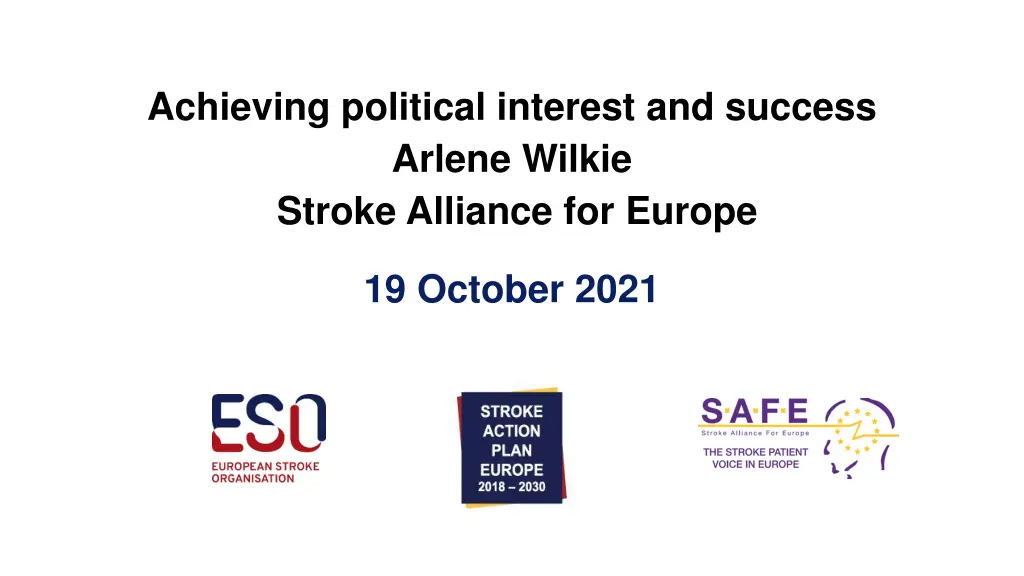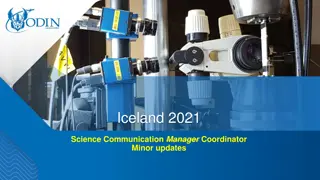
Achieving Political Interest and Success with Stroke Alliance for Europe
"Learn about the Stroke Alliance for Europe, its mission, impact, and the importance of the Stroke Action Plan for Europe. Discover the challenges faced by stroke survivors across various European countries and how the implementation committee is leading the efforts. Get involved in advocating for improved stroke care across Europe!"
Download Presentation

Please find below an Image/Link to download the presentation.
The content on the website is provided AS IS for your information and personal use only. It may not be sold, licensed, or shared on other websites without obtaining consent from the author. If you encounter any issues during the download, it is possible that the publisher has removed the file from their server.
You are allowed to download the files provided on this website for personal or commercial use, subject to the condition that they are used lawfully. All files are the property of their respective owners.
The content on the website is provided AS IS for your information and personal use only. It may not be sold, licensed, or shared on other websites without obtaining consent from the author.
E N D
Presentation Transcript
Achieving political interest and success Arlene Wilkie Stroke Alliance for Europe 19 October 2021
Stroke Alliance for Europe (SAFE) Who are we SAFE is a non-profit-making organisation formed in 2004 in Brussels, Belgium. We are the voice of stroke survivors in Europe. We represent stroke support organisations (SSOs) from more than 30 European countries. Our vision To work towards greatly decreasing the number of strokes in Europe and that all who are touched by stroke get the help and support they need. Our aims To reduce the numbers and the effects of strokes across Europe. What we do to the advancement of stroke prevention and the improvement of the quality of life of stroke survivors, Help grow and develop stroke support organisation Campaigning at a European level, and by supporting members to do so locally. Encouraging research
Why is the Stroke Action Plan for Europe important? Due to deficiency of post- stroke services, stroke survivors leave for psychiatric hospitals or institutions for mentally handicapped people . Czech Republic There is no state certification/ accreditation of stroke units. As such we have no medical specialty stroke medicine . Thus stroke patients are treated not by specially educated stroke physicians, but mainly by general neurologists .Ukraine In therapy terms, patients effectively walk off a cliff after they pass through the hospital gates . Ireland There is no structured, standardised care management for stroke- patients when they return home . Germany The life after stroke is the poorest point of the care process . Spain Thousands of stroke survivors do not receive the support they need with their recovery when they leave hospital . UK (Reference: SAFE interviews with members summer 2019)
Why is the Stroke Action Plan for Europe important? Stroke is a leading cause of early death and disability Increasing numbers of strokes and cost of stroke care Disparities between & within countries along the entire stroke care pathway, with post- stroke support being neglected by all countries Many countries do not have a specific and/or a comprehensive strategy for dealing with stroke, supported with adequate funding The pandemic has only made this situation worse Fuels the need for a Stroke Action Plan to confront stroke & its impact on our European citizens References: Burden of Stroke: https://www.safestroke.eu/burden-of-stroke/ Economic impact of stroke: https://www.safestroke.eu/economic-impact-of-stroke/
Who is leading on this? Stroke Action Plan Implementation committee Chair: Professor Hanne Christensen Co-Chair: Dr Francesca Romana Pezzella and Arlene Wilkie Total 14 committee members from SAFE and ESO from across Europe All work done far is here: https://actionplan.eso-stroke.org/
What do we hope to achieve? What are we trying to achieve Getting your Government to commit to implementing a national stroke plan, to funding stroke services and to audit those stroke services How will this help? highlight stroke services that are not meeting minimum standards identify what needs to be done to bring about improvements in services plan for the recruitment and training of the stroke specialist workforce needed enable stroke support organisations to work with local health systems to promote public awareness campaigns on recognising stroke symptoms and reducing people s risk of having a stroke; and to provide much needed life after stroke support highlight issues between countries Most important of all - lead to better outcomes fewer people will die from their stroke, and more people will make a quicker and better recovery from the impact of their stroke
What have we been doing? Stakeholder analysis What did we do? Developing and supporting national coordinators in each county Communicate and work with the Ministry of Health Form a working group/ committee Information meetings and advocacy training sessions in 2020/2021 48 countries have coordinators in potential 52 countries 89 people named coordinators Be clear on what you want to change Get your voice known!
What have we been doing? Declaration 1. A national stroke plan defining pathways, care and support after stroke including pre-hospital phase, hospital stay, discharge and transition, and follow-up. 2. At least one individual from the respective Stroke Support Organisation SSO (if existent) will be involved and supported, in an equal way, during the development of each country s national stroke plan or stroke related guideline. 3. A national strategy for multi-sectorial public health interventions promoting and facilitating a healthy lifestyle and risk factor control has been implemented. 4. Establishment of national and regional level systems for assessing and accrediting stroke clinical services, providing peer support for quality improvement, and making audit data available to public. 5. All stroke units and other stroke services independent of sector undergo quality auditing continuously or with regular time intervals (% audited/certified). 6. Access to stroke unit care for patients with acute stroke (% admitted to stroke unit care <24 hours). 7. Recanalisation treatment rate provided for patients with ischaemic stroke (% receiving intravenous thrombolysis or mechanical thrombectomy calculated out of all ischaemic stroke admissions). 8. Access to: CT/MRI, vascular imaging, ECG, long-term ECG-monitoring, cardiac echo (TTE, TOE), dysphagia screening, and blood tests during stroke unit admission (% of stroke units with access). 9. Access to early stroke unit rehabilitation including early supported discharge (% access). 10. Access to basic secondary prevention including antithrombotics, antihypertensives and statins as well as life style advice (% according to WHO data). 11. A binding personalised, documented rehabilitation and sector transition plan provided at the time of discharge (% patients provided with plan). 12. Follow-up at 3-6 months after the stroke incident including a Post Stroke Check list and a functional assessment and referral for relevant interventions (% patients with follow-up)
Success! https://actionplan.eso-stroke.org/the-declaration-for-action-on-stroke/ Launch on European Stroke Awareness Day Declaration has been translated in 17 languages Signed! Progressing towards signing!
Still more to do! https://actionplan.eso-stroke.org/ THANK YOU FOR LISTENING arlene.wilkie@safestroke.eu Twitter @StrokeEurope Facebook @safestroke #StrokeStillMatters






















